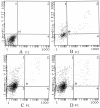Nimesulide inhibited the growth of hypopharyngeal carcinoma cells via suppressing Survivin expression
- PMID: 22453101
- PMCID: PMC3364892
- DOI: 10.1186/1758-3284-4-7
Nimesulide inhibited the growth of hypopharyngeal carcinoma cells via suppressing Survivin expression
Expression of concern in
-
Comment: Head and Neck Oncology.BMC Med. 2014 Feb 5;12:24. doi: 10.1186/1741-7015-12-24. BMC Med. 2014. PMID: 24499430 Free PMC article. Review.
Abstract
Background: The objective of this study was to evaluate the efficacy of Nimesulide, a selective cyclooxygenase-2 (COX-2) inhibitor, on the growth of hypopharyngeal carcinoma cells (FaDu) in vitro, and investigate its potential mechanism.
Methods: After FaDu cells were treated with graded concentrations of Nimesulide for divergent time, sensitivity of cells to drug treatment was analyzed by MTT assay. Morphological changes of FaDu cells in the presence of Nimesulide were observed by acridine orange cytochemistry staining. Proliferating cells were detected using the 5-Bromo-2'-deoxy-uridine (BrdU) incorporation assay. Following cells were subjected to Nimesulide (500 μmol/l) for 6 h, 12 h and 24 h, the percentage of apoptosis was examined by flow cytometry. We detected COX-2 and Survivin expression change by RT-PCR and Western blot, and analyzed the correlation of them with the growth of FaDu cells. Additionally, we also analyzed Caspase-3, Bcl-2 and Bax expressions as markers to investigate the related pathway of Nimesulide-indued apoptosis.
Results: Compared with the control group, the viabilities rates were decreased by Nimesulide in time- and dose-dependent manners, typical morphological changes of apoptotic cells were observed in the Nimesulide-treatment groups, Nimesulide could suppress the proliferation of FaDu cells significantly. The percentage of apoptosis in FaDu cells were markedly increased after Nimesulide-treatment for 6 h, 12 h and 24 h. Nimesulide down-regulated the Survivin and COX-2 expressions at mRNA and protein levels in FaDu cells. Additional analyses indicated that Bcl-2 expression was significantly decreased and the expressions of Caspase-3 as well as Bax were increased at both mRNA and protein levels.
Conclusions: Based on the induction of apoptosis and suppression of proliferation, Nimesulide could inhibit the growth of FaDu cells. Furthermore, the suppression of Survivin expression may play an important role in Nimesulide-induced growth inhibition. Nimesulide could act as an effective therapeutic agent for hypopharyngeal carcinoma therapy.
Figures






References
-
- Ristimaki A, Sivula A, Lundin J, Lundin M, Salminen T. et al.Prognostic significance of elevated cyclooxygenase-2 expression in breast cancer. Cancer Res. 2002;62(3):632–635. - PubMed
Publication types
MeSH terms
Substances
LinkOut - more resources
Full Text Sources
Medical
Research Materials

